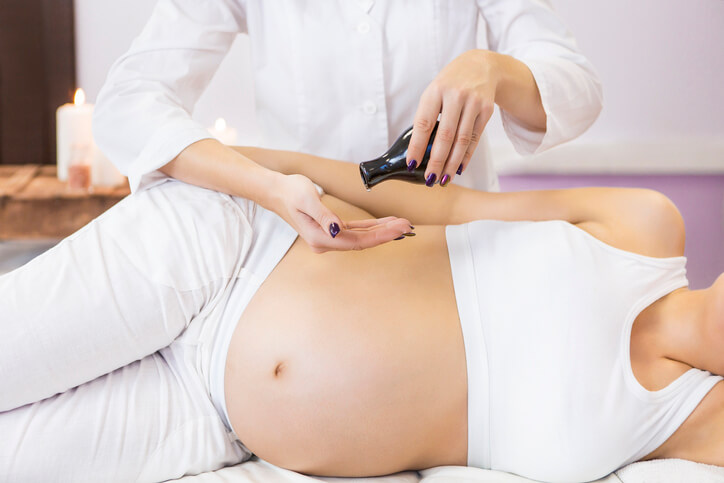Massage has been used for centuries to reduce muscle tension, relieve stress, and improve overall health and wellness.
Pregnant women can benefit from massage as well, which can not only improve your pregnancy journey, but even improve labor and delivery outcomes.
This guide from PregnancyResource.org explains what prenatal massage is, how safe it is for pregnant women, and the benefits of massage during pregnancy.
What Is Prenatal Massage?
During a traditional deep tissue massage, you might spend most of the time lying face-down on a massage table.
However, this is not possible for those growing a baby in their belly.
Conversely, many pregnant women aren’t able to lie flat on their backs because this can put pressure on major blood vessels and disrupt proper circulation.
A prenatal massage takes all of this into consideration.
A prenatal massage is performed in different positions that feel most comfortable for the expecting mother, and also uses special cushions or holes in the massage table to accommodate a growing belly.
A prenatal massage is based on Swedish massage therapy, which uses kneading, rolling, and percussion to smooth out tense muscles while increasing lymphatic circulation.
Massage oil can be used to prevent friction between skin.
Searching pregnancy products? We have some recommendations! 🤰🤰
👶👶 TOP RECOMMENDATION: The Genate Prenatal Nutritional Test: Optimize the prenatal nutrition you share with your developing baby or newborn: LEARN MORE.
——- Additional Recommendations ——
📚 Mayo Clinic Guide to a Healthy Pregnancy, 2nd Edition: LEARN MORE.
📚 The Pregnancy Encyclopedia: All Your Questions Answered: LEARN MORE.
🧘 WorkoutLabs Prenatal Yoga & Ayurveda Cards: LEARN MORE.
*If you buy something from a link on our site, we may earn a commission. See our advertising disclosure.
Is Prenatal Massage Safe?
As long as you go to a trained practitioner, prenatal massage is generally considered very safe.
Because every woman is different, it is important to speak up about any accommodations that you need, whether it’s extra cushions, unscented massage oil, or using lighter pressure if you’re feeling too tender.
Once you’re beyond the first trimester of your pregnancy, it’s best to avoid lying on your back.
The extra weight can compress major blood vessels in your back, reducing circulation and blood flow.
It’s also a good idea to avoid deep tissue work during pregnancy, which a trained masseuse will know.
This is because pregnant women are susceptible to blood clots, which can be dislodged if the massage goes too deep. As an alternative, light and gentle strokes should be used during the massage.
Some massage therapists claim that by using certain pressure points, they can help to induce contractions and speed up labor.
There is little scientific evidence to support this claim.
However, if this concerns you, you might want to ask your massage therapist to avoid certain areas, such as the one between the ankle and the heel.
What Are the Benefits of Prenatal Massage?
The benefits of prenatal massage can be felt throughout your entire pregnancy, labor, and even in the postpartum period.
Here are the greatest benefits associated with prenatal massage:
Reduced Pain
Beginning in the second half of pregnancy, women tend to feel pain in the abdomen, lower back, legs, and groin area.
Aside from being uncomfortable, the pain of loosening ligaments around the uterus and abdomen area in general can make it difficult for pregnant women to move around.
A professional massage can help provide pain relief by relaxing major muscles and improving blood flow.
For instance, one study found that prenatal massage could relax the sciatic nerve, which can significantly improve leg and back pain.
If you experience pain in specific muscles during your pregnancy, you can ask your massage therapist to give some extra attention to them for relief.
Reduced Swelling
Fluid build-up is a common pregnancy symptom, especially affecting the feet, calves, and ankles.
Massage stimulates lymphatic circulation, which can reduce some of this fluid build-up.
Studies confirm this, showing that just 20 minutes of foot massage can significantly reduce foot swelling during pregnancy.
Improved Mood
Mood changes, such as depression and anxiety, are common both during and after pregnancy.
Prenatal massage can help to improve some of these negative mood changes by releasing endorphins, the brain’s “feel-good” chemicals.
This boost can help reduce the effects of stress hormones like cortisol, working to relax the body and mind.
Studies show that women who get a regular massage during pregnancy report lower rates of anxiety and depression, as well as get better sleep (a significant impactor of mood), than those without massage.
In addition, they were less likely to suffer from postpartum depression.
Genate is the first comprehensive prenatal genetic nutrition test helping mothers understand how they share important nutrients with their developing babies.
- The report shows how your unique genetics contribute to potential nutritional deficiencies that affect your baby's cognitive development.
- The Genate Test is fast and easy-to-do: Take test at home, Receive Your Precision Nutrition Report, Overcome Nutritional Challenges
- The Genate prenatal nutrition test helps you optimize the prenatal nutrition you share with your developing baby or newborn.
Fewer Complications During Labor
In addition to making you feel great during pregnancy, prenatal massage can also improve labor outcomes.
Studies show that regular massage during pregnancy makes labor feel less painful and even reduce total labor time by up to three hours.
There are additional benefits to a special type of massage called a perineal massage.
This type of massage targets the perineum — the area between the vagina and the anus.
A perineal massage can make the muscles and skin of this area more elastic, which can reduce the chances of perineal tearing during birth.
It can also help prevent the need for an episiotomy, which is a surgical cut in this area that makes it easier to deliver the baby.
Who Can Do a Prenatal Massage?
Technically speaking, any certified massage therapist can perform a prenatal massage.
However, it’s always best to go to a practitioner with experience providing massage therapy to pregnant women.
When choosing a massage therapist for prenatal massage, try to find a specialist. You may also try asking your OB/GYN for referrals.
Once you find a potential masseuse, ask to see a certificate of training in prenatal massage.
To relieve any of your worries, read about the specific certification that a masseuse has and ask any questions that you may have about their technique.
In Conclusion
A prenatal massage has many benefits during and after pregnancy.
A regular prenatal massage is associated with a reduction in pain and swelling, an improvement in mood, and shorter labor duration.
A special type of massage called a perineal massage can also reduce the risk of tearing during childbirth.
Contact your healthcare provider before giving prenatal massage a try if you have a high-risk pregnancy or other health concerns, like preeclampsia.
To find the right prenatal massage therapist, look for someone with a certification and many hours of experience giving massages to expecting mothers. After that, all you have to do is lie back, relax, and reap the benefits of prenatal massage.
References and Sources:
Safety and Pregnancy Massage: a Qualitative Thematic Analysis | PMC
Pregnancy and Labor Massage | Tandonline
Effect of Foot Massage To Decrease Physiological Lower Leg Edema in Late Pregnancy | NCBI
Massage Therapy Effects on Depressed Pregnant Women | NCBI
Effect of Massage Therapy on Duration of Labor: A Randomized Controlled Trial | PMC

Bridget Reed is a Tampa-based content development manager, writer, and editor at GR0; specializing in content related to varying fields including medicine, health, and small businesses. Bridget went to St. Petersburg College and majored in Management and Organizational Leadership.
Recent Publications: Body Acne 101: Prevention and Treatment, Stress Acne: Causes, Prevention, and Treatment, What are the Side Effects of Midol?


